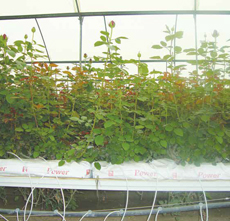By Mary Mwende
 Floriculture, has evolved significantly in recent years with the emergence of two distinct approaches: hydroponic and substrate-based systems. These methods offer unique advantages and require specialized nutrition management strategies to ensure the healthy growth and vibrant blooms of flowers. Hydroponic floriculture relies on a soilless environment, with essential nutrients delivered through precisely balanced nutrient solutions, while substratebased floriculture employs solid, soilless substrates supplemented with additional nutrients.
Floriculture, has evolved significantly in recent years with the emergence of two distinct approaches: hydroponic and substrate-based systems. These methods offer unique advantages and require specialized nutrition management strategies to ensure the healthy growth and vibrant blooms of flowers. Hydroponic floriculture relies on a soilless environment, with essential nutrients delivered through precisely balanced nutrient solutions, while substratebased floriculture employs solid, soilless substrates supplemented with additional nutrients.
Hydroponic Floriculture
Hydroponics is a soilless growing system where plants are cultivated in an inert medium, such as rock wool, coco coir, or perlite. These media serve as physical supports for plants, but they do not provide any nutritional value. In hydroponic floriculture, all essential nutrients are supplied through a carefully balanced nutrient solution.
Growing Medium: The growing medium in hydroponic systems is essentially an anchor for plant roots. It is chosen for its inert nature, moisture retention capabilities, and the ability to hold the plant in place. The absence of soil eliminates the risk of soil-borne diseases and pests, offering a more controlled environment for plant growth.
Nutrient Solution: The heart of hydroponic floriculture lies in the nutrient solution. This solution is a carefully calibrated mixture of essential macronutrients (nitrogen, phosphorus, potassium) and micronutrients (iron, zinc, manganese, etc.), dissolved in water. The nutrient solution is delivered directly to the plant roots through various hydroponic systems, such as drip irrigation, flood and drain, or nutrient film technique (NFT).
pH and EC Control: One of the key aspects of hydroponic nutrition management is maintaining the pH and electrical conductivity (EC) of the nutrient solution within optimal ranges. Different plant species have specific pH and EC requirements, and these parameters need to be monitored and adjusted regularly. Deviations from the optimal pH or EC levels can lead to nutrient imbalances and deficiencies.
Precision and Control: Hydroponic systems offer a high degree of precision and control over nutrient delivery. Growers can easily adjust the nutrient levels to meet the specific needs of different plant varieties, leading to faster growth, higher yields, and improved crop quality. This level of control is particularly advantageous for commercial floriculture operations where uniformity and consistency are essential.
Hygiene and Disease Control: Hydroponic systems are generally more hygienic compared to traditional soil-based systems because they reduce the risk of soil-borne diseases. However, maintaining hygiene in the system is crucial. Regular cleaning and sanitation are necessary to prevent issues like algae growth in the nutrient solution, which can disrupt plant health.
Substrate-Based Floriculture
In substrate-based floriculture, plants are cultivated in solid, soilless substrates like peat, coconut coir, perlite, or a blend of these materials. Unlike hydroponic systems, substrates do offer some initial nutrients and serve as a physical support for plant roots. However, they are generally not sufficient to meet the plants’ nutritional requirements throughout their growth cycle, necessitating additional nutrient management.
Growing Medium: The substrate serves as both a structural support for the plants and a reservoir for water and nutrients. The choice of substrate can influence water retention and aeration characteristics, which in turn affect root health and nutrient uptake. Substrate-based systems strike a balance between the benefits of soil-based systems and the control offered by hydroponics.
Nutrient Management: While substrates provide some initial nutrients, these are typically insufficient for the entire growth cycle. Therefore, growers need to supplement the substrate with additional nutrients. This can be accomplished through the incorporation of slow-release or controlled-release fertilizers into the substrate or by periodic application of liquid fertilizers through irrigation.
pH and EC Considerations: Monitoring and adjusting the pH and EC of the substrate is important in substrate-based floriculture as well. The choice of substrate and the type of water used for irrigation can influence these parameters. While the pH and EC dynamics are generally less dynamic in substrates than in hydroponic systems, maintaining them within optimal ranges remains critical.
Watering and Drainage: Proper irrigation management is crucial in substrate-based floriculture. Overwatering can lead to waterlogged conditions, which restrict oxygen availability to the roots and can result in root rot. Adequate drainage is necessary to prevent such issues and ensure that the substrate remains well-aerated.
Nutrient Buffering: Substrates have the ability to buffer or retain nutrients to some extent. This provides a margin of safety against sudden nutrient imbalances and fluctuations. However, it also means that nutrient management may be less precise compared to hydroponic systems. Growers must be aware of the substrate’s nutrient buffering capacity to avoid over- or under-fertilization.
In conclusion, both hydroponic and substrate-based floriculture have their unique advantages and challenges when it comes to nutrition management. Hydroponics offers precision and control, allowing growers to fine-tune nutrient delivery to meet the specific needs of plants. It also reduces the risk of soil-borne diseases and pests. On the other hand, substrate-based floriculture provides a balance between the structure of traditional soil-based systems and the controlled environment of hydroponics. The choice between these methods depends on various factors, including the specific plant varieties being grown, available resources, and the expertise of the growers. Regardless of the method chosen, careful nutrition management is essential for healthy and vibrant flowers.


